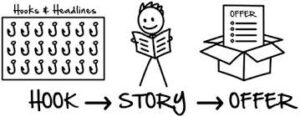You can have the best product or service in the world, but if you don’t know how to get it in front of the right people you’re probably not going to sell a lot.
Getting your product in front of the wrong people can also be very costly. This is why it’s so important to really understand your target audience.
What is a target audience?
Your target audience is the people most likely to be interested in your product or service. They are the people that you want to focus your marketing efforts towards as they are most likely to become customers.
Your target audience may share certain demographics such as age, location, gender, socio-economic status, etc. Your business may have more than one target audience if you sell a variety of different goods and services.
You may have one target audience per product or may have several target audiences for the same product, each segmented according to those factors that makes sense to your business e.g. location, age, etc.
Target audiences are not one-size-fits-all
It is very unlikely that you will be selling something that everyone wants or needs. Even though you may feel that your product will revolutionise the world and is something that everyone needs, the truth is most people don’t care, need, or want your product.
The majority of people don’t care about you or your product. Harsh but it’s true. If you try to market to everyone you will end up blowing through your marketing budget very quickly without seeing much returns.
In order to spend your budget wisely and sell more products, you need to focus your efforts on the people who will see value in owning and using your product. The sooner you realise that the majority of people don’t care, want, or need your product the sooner you will start to focus your attention on those that do.
In order to do this you need to know who your target audience is.
Breaking down your target audience
1. Firstly you need to identify what market you are in.
Examples of different markets: health, finance, relationships, personal development, travel, etc.
2. Then you need to identify your sub-market within that market.
Sub-markets are categories that exist in your main market.
Example: If you are in the health market your sub-market may be weight loss, muscle gain, physiotherapy, mental health, etc.
3. Once you identify your sub-market you then dig a little further by identifying your niche.
Your niche is the specific segment of your sub-market that you are targeting.
Although you may feel that everyone in your sub-market is your target customer, if you dig further you will find niches within your sub-market that are more refined and targeted – this is the specific group or distinct segment of your sub-market you want to serve.
Example:
- Market = Health
- Sub-market = Weight loss
- Niche = Weight loss for women
You can see how much more targeted “weight loss for women” is compared to “health” or just “weight loss” which are too vague and broad.
Once you have identified the niche of people that will buy, use, and benefit from your product you can now take a more focused and targeted approach to your market research in order to understand your audience better.
What do you need to know about your target audience?
Ideally, the more data points you can gather on your target audience the better. There are some key questions you should be asking.
The general demographic information you may want to know:
- Where do they live?
- How old are they?
- Where do they shop – what are their favourite brands?
- What websites do they visit?
- What online platforms do they use?
- Are they married?
- Do they have kids?
- What job do they do?
- What is their annual income?
- What are their interests?
More specific things related to your audience and niche you may want to know:
- What other products are on the market? What do online reviews say about those products?
- What are their goals for using your product – what result do they want?
- What emotions do they want to feel when they achieve that result?
- What other products can you sell to complement your main product?
- Who are the influencers in this market?
- What websites do people in my niche visit? What blogs do they read/subscribe to? What social media platforms do they use? What groups/forums do they belong to?
Example of how this would look using our “weight loss for women” niche:
Using our “weight loss for women” niche example, here are some questions we may ask about our target audience:
- How old are they?
- Are they a member of a gym?
- How often do they exercise?
- What is their current diet like?
- What weight loss and exercise groups/forums do they belong to?
- What other weight loss products have they used previously? What did they like/dislike about those products?
- What are their goals for using your product? – How much weight do they want to lose? In what time span?
- What other products can you sell to complement your main product? – Exercise equipment, Diet plans, etc
- Who are the influencers in this market?
- What websites do people in my niche visit?: What social media platforms do they use? What blogs do they read? What search terms do they type when browsing for weight loss information?
By asking the right questions you will get a deeper insight into your target audience and ideal customers, and armed with these insights you can more effectively target them with your marketing efforts.
Understanding your target audience = highly targeted marketing
When you truly understand your target audience and niche you will be in a position to create highly targeted and super-relevant marketing campaigns. You will be able to reach them at the right place, at the right time, with the right offer.
When you know what websites they visit or where they congregate online you can target them with paid ads. By knowing where they “hang out” online you can start joining in on the conversations they are having within these online communities, and start to build trust and awareness of your brand or product.
You can also reach out to the influencers in your market and see if you can promote your offer to their audience or list. These influencers have already gathered large followers and congregations of your ideal customer, so doing some cross-promotional campaigns will get your product or offer in front of a highly targeted and super-relevant audience.
The more you understand your target audience the better you can serve them
As marketers, salespeople, and business owners our focus should be on serving our customers to the best of our ability.
Instead of being solely focused on how we can market and sell our products, we should focus on how we can be of better service to our customers. Taking a customer-centric view will help you to put yourself in their shoes. You will understand them better – their pain points, their desires and goals, and the obstacles they are facing.
You can then use this information to create marketing campaigns, ads, and sales pages that resonate and connect with your target audience, thus helping to establish understanding and trust.
When you understand your target audience you can offer a better service, better products, and better after-sales service. You will build longer lasting relationships with your customers, helping to turn them into raving fans and brand advocates.




